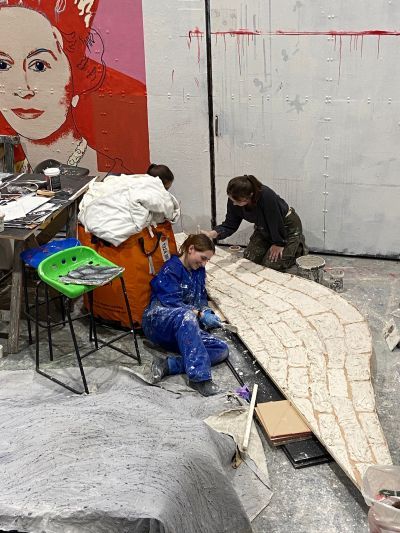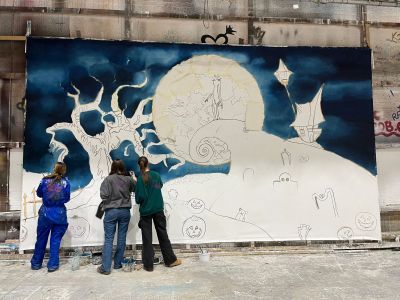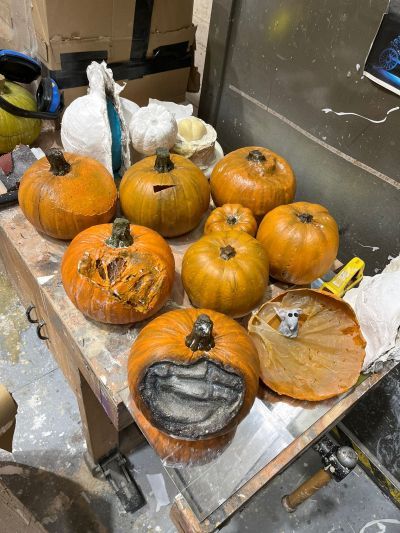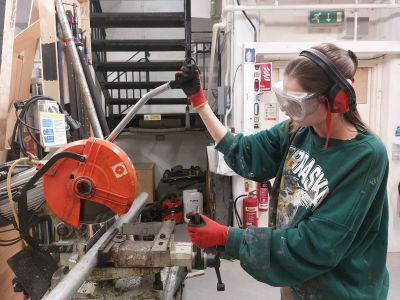
Breadcrumb navigation
In Conversation with BA Production Arts, Design Realisation students Hannah Rhind & Tia Alexandrou

In Conversation with BA Production Arts, Design Realisation students Hannah Rhind & Tia Alexandrou
Meet Hannah and Tia, first year students, studying BA Production Arts, Design Realisation. We discussed how they worked together on a set design project inspired by Tim Burton's film A Nightmare before Christmas. From creating scenery to making the pumpkin props, hear more about their first major collaboration.
You are both in your first year at Guildhall. Can you explain why you chose to study Production Arts and specifically Design Realisation?

Hannah: I chose to pick this course as I've always had a love for drama and art, so when it came to picking a university course I thought it would be best to find one that combined both of my main interests.
I specifically had always had an interest in props and scenic painting as I watched a lot of science fiction TV shows when I was younger. I was amazed by how people can make a room transform into a whole different planet/dimension through this art.
Tia: I have always been interested in theatre and have loved going to see musicals and shows since being a child. I have also always been creative and loved making things, which started my curiosity in this field. In secondary school I was fortunate enough to go to a school which had Production Arts as a BTEC in both GCSE and A-Level. I did both of these, which together took four years, and this furthered my love for creating things within a theatre setting. Those few years of studying the broader version of Production Arts, and loving the props aspects I got to do, led me to choose Design Realisation at Guildhall.

You have both been working on a four-week project to build a set design inspired by the work of the director Tim Burton and his animated film The Nightmare Before Christmas. Can you tell us about this experience over the different stages?
Hannah: When I heard about the brief I wasn't familiar with the movie so my first step was to watch it. I found it really entertaining and it sparked a lot more of my ideas, this was then heightened after visiting the Design Museum to see the Tim Burton exhibition. I really felt like I understood Tim Burton’s creative process and I was then excited to replicate this creative process when making our own set.
Tia: I was quite excited but nervous after getting the project brief. Our brief included a model box of the design and some information. There were so many interesting elements within the model box that I could not wait to get started making it, but it was also slightly nerve-wracking as I had not created anything like this on such a large scale before. The exhibition was very helpful and inspiring, as it showed some of the models and figures used in the movie, as well as information about Tim Burton and his process in creating it. The exhibition also showed me information about some of the other movies Burton has created, which were good things for me to look into for references and inspiration during the project.
Two weeks of the project was for working on planning and scheduling. What did this involve? How did you go about sampling elements?

Hannah: We specifically prototyped the props and scenic elements. We painted small sections of the mural whilst making sure we swatched our colours and noted how we made all the elements. We did a trial and error technique for the material used for the prop pumpkins. Even though this method was time consuming, it really helped me learn about so many new materials that I was previously not familiar with.
Tia: We completed many different tasks over these two weeks which included planning and sampling as well as working on real elements of the set. The planning and scheduling involved creating timetables for us as a group to ensure that everyone was always working on something to further the project efficiently. For sampling elements, the two of us did a lot of work in scenic art. Some of the samples we worked on were for the backcloth. Before we could start drawing and painting, we needed to do a few sample paintings as practice. I chose to do a sample which included the moon and the spiral hill that Jack Skellington stands on. This sample was a way for me to practice my drawing skills, as well as my painting skills and techniques.
The third week was for creating the backcloth/scenery and making props. What did this involve?

Hannah and Tia: One of the props that we both worked on was creating the pumpkins that would be used to dress and fill the set. To create the pumpkins we used different types of expandable foams – a soft one and a hard (‘biscuit’) foam. This process of creating the pumpkins took a lot of trial and error with the foam as it can be a tricky medium to work with. During this process we also made two casting moulds out of real pumpkins that we were able to use to create foam pumpkins from. After creating them out of foam, we then painted them to create the fake appearance of a real pumpkin. For some of them we also carved into them to create appearances of mould and pulp as if the pumpkin had been smashed up.

The final part of the project was fit up week. How did that go?
Hannah and Tia: Putting the set up during this time required a lot of teamwork across the whole class and with the lecturers. This is because a lot of it involved heavy lifting and manoeuvering of the many large set pieces. When we moved these, we communicated well as a team to ensure that we acted safely and that we all agreed on the placement of the elements. This time was also when we completed the task of painting the floor. To do this we had to draw around the elements of the set that were marked in place. We then used paint to create the streaked floor part of the model box and the cobbled stone effect on part of it.
How was the actual show day to the rest of the school? How did the pre-show prep go? What did you enjoy most about the project and what did you learn?
Hannah: The pre-show prep was a lot more chilled compared to the days beforehand, as we were so conscious of time that when it was show day it felt like the only things left to do were dressing the set and cleaning up the workshops for visitors.
The actual show went amazingly. We had so many people turn up and they were really intrigued by what we did as a course. By the end of the exhibition we all felt so empowered and happy about the reactions.
My favourite part of this project was fit up as it was so satisfying to see all these elements we have been working on for weeks being completed and coming together. I learnt so much during this project. I learnt heaps more about techniques and products, especially during props.
Tia: I enjoyed the show day, hearing and seeing people's reactions to the set and the moving elements was so rewarding. It validated all the work and effort we had put in. What I enjoyed most about this project was being given the freedom from the lecturers to work how we liked and to figure out the tasks by ourselves. This was extremely cool as we were given complete creative freedom which made us work even harder than usual.
Looking to study Production Arts with us in 2025? Explore our upcoming Production Arts Open Days and learn more about our application and interview process.

